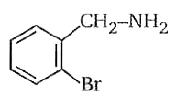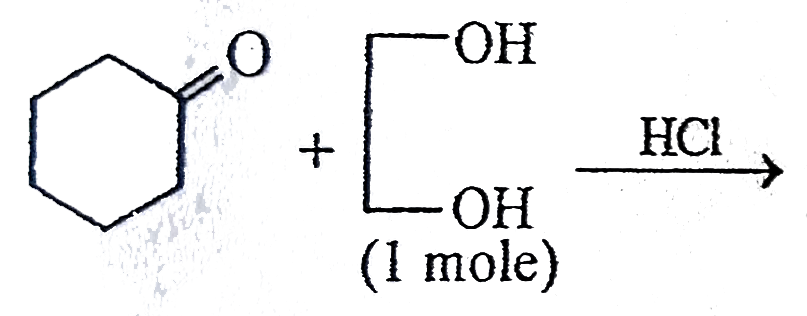What is the product obtained when glycine hydrochloride reacts with two equivalents of NaOH ? Write the chemical reactions involved.
The correct Answer is:ClΘH3⊕N−CH2∣∣Oglycinehydrochloride−C−OH+NaOH1st eqv.→⊕NH2CH2O∣∣COΘ+H2+NaCl
⊕NH3CH3C∣∣O−OΘ+NaOH2nd eqv.→H2N−CH2−O∣∣C−OΘNa⊕+H2O.
To determine the product obtained when glycine hydrochloride reacts with two equivalents of NaOH, we will follow these steps:
Step 1: Identify the structure of glycine hydrochloride
Glycine (NH2CH2COOH) is an amino acid that exists in its zwitterionic form when in solution. When glycine reacts with hydrochloric acid (HCl), it forms glycine hydrochloride, which can be represented as:
NH+3CH2COO−Cl−
Step 2: Reaction with the first equivalent of NaOH
When glycine hydrochloride reacts with the first equivalent of sodium hydroxide (NaOH), the following occurs:
- NaOH dissociates into Na⁺ and OH⁻ ions.
- The Na⁺ ion will combine with Cl⁻ to form NaCl.
- The OH⁻ ion will react with the H⁺ from the ammonium group (NH₃⁺) to form NH₂ (the amino group).
The reaction can be written as:
NH+3CH2COO−Cl−+NaOH→NH2CH2COO−Na++NaCl+H2O
Step 3: Reaction with the second equivalent of NaOH
Now, we treat the product from the first reaction (sodium glycinate) with another equivalent of NaOH. The reaction proceeds as follows:
- The Na⁺ ion will remain associated with the COO⁻ group.
- The second OH⁻ ion will abstract a proton (H⁺) from the carboxylic acid group (COOH) of the sodium glycinate.
The reaction can be represented as:
NH2CH2COO−Na++NaOH→NH2CH2COO−Na++H2O
Final Product
After both reactions, the final product is sodium glycinate (sodium salt of glycine):
NH2CH2COO−Na+
Summary of Reactions
1. Glycine hydrochloride reacts with NaOH to form sodium glycinate and NaCl.
2. Sodium glycinate remains stable in the presence of the second equivalent of NaOH, resulting in the same sodium glycinate.
Final Answer
The product obtained when glycine hydrochloride reacts with two equivalents of NaOH is sodium glycinate (NH₂CH₂COO⁻Na⁺).
---
Glycine (NH2CH2COOH) is an amino acid that exists in its zwitterionic form when in solution. When glycine reacts with hydrochloric acid (HCl), it forms glycine hydrochloride, which can be represented as:
When glycine hydrochloride reacts with the first equivalent of sodium hydroxide (NaOH), the following occurs:
- NaOH dissociates into Na⁺ and OH⁻ ions.
- The Na⁺ ion will combine with Cl⁻ to form NaCl.
- The OH⁻ ion will react with the H⁺ from the ammonium group (NH₃⁺) to form NH₂ (the amino group).
Now, we treat the product from the first reaction (sodium glycinate) with another equivalent of NaOH. The reaction proceeds as follows:
- The Na⁺ ion will remain associated with the COO⁻ group.
- The second OH⁻ ion will abstract a proton (H⁺) from the carboxylic acid group (COOH) of the sodium glycinate.
After both reactions, the final product is sodium glycinate (sodium salt of glycine):
1. Glycine hydrochloride reacts with NaOH to form sodium glycinate and NaCl.
2. Sodium glycinate remains stable in the presence of the second equivalent of NaOH, resulting in the same sodium glycinate.
The product obtained when glycine hydrochloride reacts with two equivalents of NaOH is sodium glycinate (NH₂CH₂COO⁻Na⁺).
Topper's Solved these Questions
- BIOMOLECULESBOOK - RESONANCE ENGLISHCHAPTER - BIOMOLECULESEXERCISE - Ex-1(sec-C)Part-I
5 Videos
- BIOMOLECULESBOOK - RESONANCE ENGLISHCHAPTER - BIOMOLECULESEXERCISE - Ex-1(sec-A)Part-II
17 Videos
- BIOMOLECULESBOOK - RESONANCE ENGLISHCHAPTER - BIOMOLECULESEXERCISE - Ex-1(sec-A)Part-I
10 Videos
- BASIC CONCEPTSBOOK - RESONANCE ENGLISHCHAPTER - BASIC CONCEPTSEXERCISE - ORGANIC CHEMISTRY(BASIC CONCEPTS)
27 Videos
- BIOMOLECULES & POLYMERBOOK - RESONANCE ENGLISHCHAPTER - BIOMOLECULES & POLYMEREXERCISE - ORGANIC CHEMISTRY(Biomolecules & Polymer)
34 Videos
Similar Questions
Knowledge Check
What is the major product obtained in the following reaction
 A
A B
B C
C D
D
What is the major product obtained in the following reaction ?
 A
A B
B C
C D
D
What will be the most probable product when compound 'X' is treated with two equivalents of NaOH

View SolutionWhat is the major product obtained from the following reaction :-

View Solution_S01_500_Q01.png) is the final product obtained when one of the following is reacted with base :
is the final product obtained when one of the following is reacted with base :
View SolutionWhat is the product when acetylene reacts with HOCl
View SolutionWrite the product formed when: Carbon disulfide reacts with chlorine.
View SolutionWhat is the product formed when ozone reacts with mercury?
View Solution

